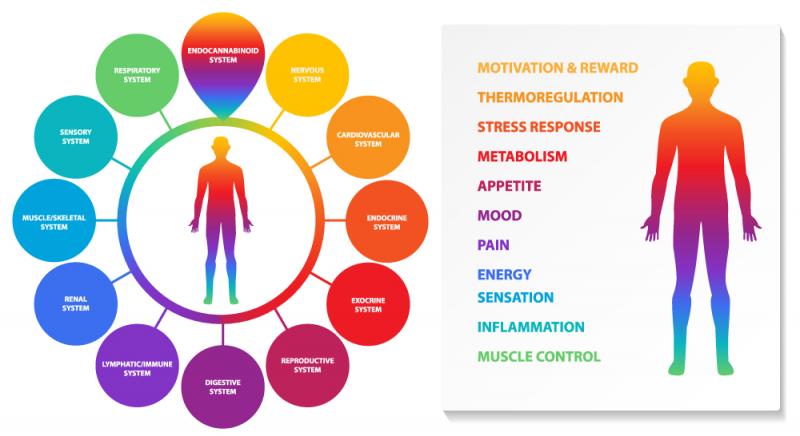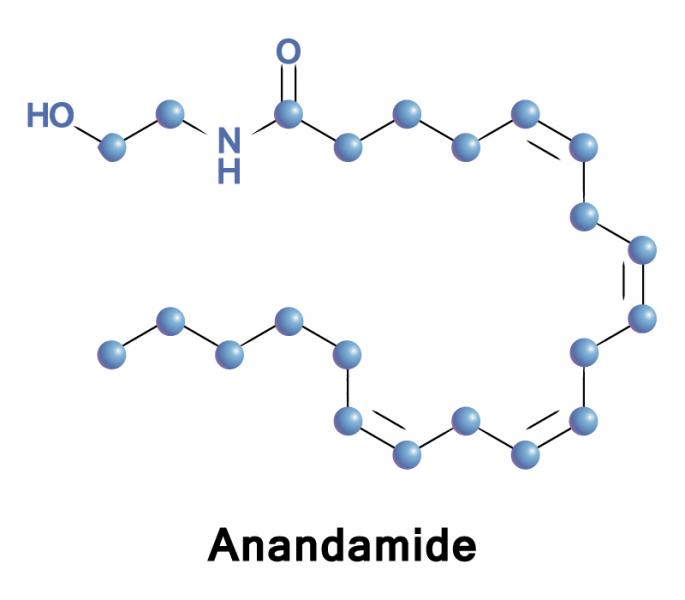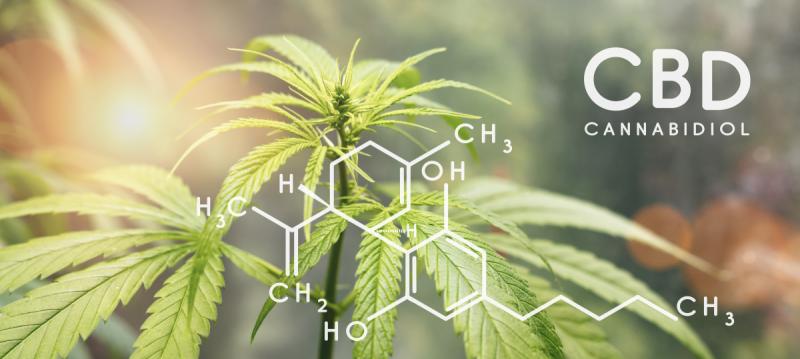
When I was using “E” [for those of you who haven’t read my first article, this is referring to the Emperor, a glycerin extract of cannabis leaf or buds a friend used to supply me with] as a remedy for severe pain I didn’t have any idea how or why it worked. The research that has been done in the last few decades has given us a better understanding of why cannabis can help relieve pain, and also aid many other chronic health problems, as well.
The answer lies in understanding the endocannabinoid system (ECS). The ECS is found in most tissues of the body and consists of chemical messengers known as endocannabinoids which attack to receptor sites on various cells. We’ll cover the subject of chemical messengers and receptor sites in greater detail in the next chapter (article), but for now, you just need to know that cells send messages to each other by releasing chemicals that attach to receptor sites and other cells.
Hormones, neurotransmitters, and prostaglandins are all examples of these chemical messengers that cells use to “talk” to each other. These systems are all aimed at trying to keep the body’s structure and function in proper balance for optimal health and the balanced state of the body, the state which equates with health and wellbeing, is called homeostasis.
The research suggests that the primary role of the ESC is to help maintain this homeostasis. It does this by regulating nerve transmission and immune activity throughout the body. This makes it unique among the body’s messaging systems. The other chemical messengers are all designed to alter cellular function to perform specific activities such as regulating growth and metabolism, facilitating reproduction, making muscles move and so forth.
The ESC, on the other hand, appears to be focused on helping keep other chemical messengers in balance. It kicks in (or upregulates to use the more medically correct language) when there is a problem, such as stress or injury. Its role appears to be to assist the body in returning back to normal function. In short, the ECS helps keep the entire system in balance. So far, we know that the ECS aids gastrointestinal and cardiovascular function, modulates neurotransmitters and pain signals, helps maintain bone mass, aids hormonal balance, helps keep metabolism in balance and modulates the immune system, including reducing inflammatory reactions and inhibiting abnormal cells.
Endocannabinoids
Five endocannabinoids, used to transmit messages within the ECS, have been identified so far. The three endocannabinoids we’ll discuss here are anandamide (AEA), arachidonoylglycerol (2-AG) and N-arachidonoyl dopamine (NADA).

Anandamide (AEA) was discovered in 1992 and is primarily involved in regulating the nervous system. The name comes from the Sanskrit—
ananda means inner bliss or tranquility. Anandamide has been called the “bliss molecule,” because it promotes a feeling of wellbeing and happiness. AEA has anti-inflammatory and anti-cancer effects. It helps decrease blood pressure and heart rate and regulates metabolism.
Arachidonoylglycerol (2-AG) was discovered three years later in 1995. It’s the most abundant of the endocannabinoids. It is found in abundance in the central nervous system where it helps regulate neurotransmitter functions. 2-AG modulates the perception of pain, feelings of anxiety or depression, and helps control the tendency for addiction. It is also anti-inflammatory, modulates immune responses, and regulates food intake and metabolism.
N-arachidonoyl dopamine (NADA) was discovered in 2000. It appears to play a role in inflammation and pain perception and to have a protective effect on the brain. It also relaxes blood vessels and may help the brain repair when it has been damaged.
Cannabinoid Receptors

There are two basic types of receptors for these endocannabinoids. They are known as CB1 and CB2 receptors.
CB1 receptors are primarily found in the brain and nervous system, although they are also located in the heart and circulatory system, the male and female reproductive system, the digestive organs and the gastrointestinal tract. They are also found in thyroid, bones, muscles, eyes, lungs, and kidneys. Primarily CB1 receptors help balance the neurotransmitter system, including stress responses, pain, and mood.
CB2 receptors are found primarily in the immune system and organs with immune functions, such as the spleen, tonsils, skin, lungs, liver and gastrointestinal tract. CB2 receptors can also be found in the brain, heart, kidneys, pancreas, bones, and gallbladder. Primarily CB2 receptors help modulate immune processes and inflammation.
Phytocannabinoids
Phytocannabinoids are compounds found in plants that attach to the body’s cannabinoid receptors. This is not an unusual thing. Many medicinal plants have been found to contain compounds that attach to cellular receptors. For example, phytoestrogens attach to estrogen receptor sites, the opioids in opium poppy attach to opioid receptors and the ephedrine in Chinese ephedra attaches to receptors for the neurotransmitter epinephrine.
About 100 different phytocannabinoids have been identified in cannabis, but the primary ones are THC and CBD. Other cannabinoids in cannabis include CBG, CBN, CBC, THCA, CBDA, THCV, CBDV and CBGA. Cannabinoids have also been found in other medicinal herbs including echinacea, kava kava, green tea, and chocolate. We may find other herbs that have effects on the endocannabinoid system later, but for now, let’s just take a look at the phytocannabinoids found in cannabis, starting with the two most well researched ones, THC and CBD.
THC (Delta-9-tetrahydrocannabinol) was first discovered in 1964, although there is some evidence it may have been identified before that time. It is produced when a compound in cannabis called THCa is heated.
THC directly binds to cannabinoid receptors and stimulates them. It’s the most psychoactive of all the known cannabinoids, so it’s what makes people high when they use cannabis. It does have some potential medical benefits, however. It reduces pain, eases anxiety and depression, aids sleep, stimulates appetite, and reduces nausea and vomiting. It has anti-inflammatory effects, can reduce seizures, relax muscle spasms and may help the body fight tumors.
There are some problems with THC, which is why the use of cannabis for recreational purposes is a controversial subject. THC, like alcohol, impairs brain function. It slows reaction time, inhibits memory and attention span, creates difficulty thinking and solving problems, reduces good judgment and interferes with balance and co-ordination.
In short, just like alcohol, it impairs a person’s ability to drive or operate other machinery. It is more difficult to detect someone driving high than someone driving drunk, and there is research suggests that you are more likely to get into a car accident when high on marijuana than when drunk.
More importantly, THC is artificially making you “feel good” by interfering with the ECS. This causes a down-regulation of the ECS where it makes you less responsive to the natural signals your body gives you to motivate you to do the right thing things.
The use of THC-rich cannabis is especially risky for teenagers, whose ECS system is still developing as they learn to adapt and cope with the normal stresses of life. Heavy use of THC rich cannabis inhibits the development of the ECS system, which decreases IQ and increases the risk of mental illness, including schizophrenia. The downregulation of the ECS is what makes a person dependent and causes withdrawal symptoms when a person discontinues the use of marijuana.
These problems have been compounded by growers, who have been creating strains of cannabis with higher levels of THC. Marijuana grown in the 1970s had only about 1-3% THC, whereas today’s varieties range from 5-30%. Both THC and the next cannabinoid we’ll discuss, CBD, are made from the same precursor chemical. This means that breeding higher levels of THC reduces the level of CBD in cannabis. Since CBD modulates the effects of THC, this increases the risk of mental illness from using marijuana in young people, as well as causing a greater downregulation of the ECS system.

CBD (Cannabidiol)is a non-psychoactive cannabinoid. It doesn’t directly bind to cannabinoid receptors like THC does. Instead it attaches to the receptors and makes them more sensitive to the body’s own endocannabinoids. So, not only does it not have the brain-altering properties of THC, it actually reduces the psychoactive effects of THC and can be taken to aid withdrawal symptoms for someone discontinuing the use of marijuana. So, shifting the balance of cannabinoids in recreational marijuana to be higher in THC and lower in CBD may be making it less beneficial for medicinal uses.
Also unlike THC, CBD does not build tolerance, nor do there appear to be any withdrawal symptoms when discontinuing it. So, CBD has many potential health benefits without the problems associated with THC. CBD is anti-inflammatory, anticonvulsant, reduces anxiety, eases depression, and helps to ease pain and relax muscles. It also aids the immune system in fighting infections and tumors. It has potential benefits for chronic inflammatory diseases, autoimmune diseases, epilepsy, digestive disorders, anxiety, depression, psychosis, and cancer.
Anyone who is concerned about the dangers of marijuana and therefore concerned about the fact that CBD comes from the cannabis plant, needs to understand that CBD itself and cannabis that is high in CBD and low in THC (which the federally mandated 0.3% for legal hemp is) cannot make you high and is completely safe for medicinal use.
One drawback of CBD products is that having a small amount of THC in them will actually help them be more effective medicinally, but it also means you could test positive on a drug test. So, if you are concerned about this, make sure you get CBD products that are THC-free.
The Entourage Effect

Many drugs used in modern medicine were compounds originally isolated from plants. Many of these compounds were later modified chemically so they could be patented. This is where the bulk of medical research into cannabis is directed. Drug companies want to try to make drugs to target specific areas on the endocannabinoid system.
Herbalists have long asserted that whole plants have beneficial effects that isolated extracts don’t. We have asserted that the wide variety of chemical compounds in a medicinal plant makes it less prone to side effects and often helps to fix the real cause of the problem, not just ease the symptoms. Those of us who believe in God, also think that the Creator knew what he was doing when he created these medicinal plants and that our tampering with them tends to make them less, rather than more, effective.
The research into cannabis seems to be supporting this assertion. Dr. Raphael Mechoulam, a Ph.D. researcher in Israel, who also happened to be the first to isolate THC and CBD in the 1960s has asserted that cannabinoids work better together than they do in isolation. He calls this the entourage effect.
This means that a whole spectrum extract containing many cannabinoids may work better than CBD alone. It also means that other compounds in cannabis have a synergistic effect that enhances the benefit of CBD and other cannabinoids.
For example, cannabis is rich in terpenoids, compounds found in essential oils. In addition to the 100+ cannabinoids in cannabis, there are also about 200 terpenoids. The varying amounts of these terpenoids in various varieties of cannabis mean that different strains have different medicinal properties. It also means that CBD may work synergistically with the essential oils used in aromatherapy. (This will be discussed in greater detail later.)
There are also about 20 flavonoids in cannabis. These compounds help to give plants their various colors and act as antioxidants, both in plants and in people. Flavonoids also work synergistically with CBD and other phytocannabinoids to give cannabis greater anti-inflammatory, antimicrobial, anticancer and anti-allergic properties.
That’s why I take the approach in this book that CBD and CBD-rich cannabis should be used along with other traditional herbal remedies, nutrition and lifestyle changes when trying to overcome various diseases. Phytocannabinoids can nudge the system back to balance, but they can’t provide the nutrients tissues need to heal or detoxify, nor do they make up for poor diet and lifestyle habits. Let’s not buy into the hype that CBD and phytocannabinoids are the latest miracle cure. Instead, we need to use them as another tool in a holistic arsenal in overcoming disease, which is something I’ll explain more thoroughly in the next installment.
I'll also be talking about the endocannabinoid system in January's Sunshine Sharing Hour. You can get it as part of the
member program, or you'll be able to order a replay of it towards the end of the month. Make sure you're signed up for my mailing list to be notified when it's available.
 When I was using “E” [for those of you who haven’t read my first article, this is referring to the Emperor, a glycerin extract of cannabis leaf or buds a friend used to supply me with] as a remedy for severe pain I didn’t have any idea how or why it worked. The research that has been done in the last few decades has given us a better understanding of why cannabis can help relieve pain, and also aid many other chronic health problems, as well.
When I was using “E” [for those of you who haven’t read my first article, this is referring to the Emperor, a glycerin extract of cannabis leaf or buds a friend used to supply me with] as a remedy for severe pain I didn’t have any idea how or why it worked. The research that has been done in the last few decades has given us a better understanding of why cannabis can help relieve pain, and also aid many other chronic health problems, as well. Anandamide (AEA) was discovered in 1992 and is primarily involved in regulating the nervous system. The name comes from the Sanskrit—ananda means inner bliss or tranquility. Anandamide has been called the “bliss molecule,” because it promotes a feeling of wellbeing and happiness. AEA has anti-inflammatory and anti-cancer effects. It helps decrease blood pressure and heart rate and regulates metabolism.
Anandamide (AEA) was discovered in 1992 and is primarily involved in regulating the nervous system. The name comes from the Sanskrit—ananda means inner bliss or tranquility. Anandamide has been called the “bliss molecule,” because it promotes a feeling of wellbeing and happiness. AEA has anti-inflammatory and anti-cancer effects. It helps decrease blood pressure and heart rate and regulates metabolism. There are two basic types of receptors for these endocannabinoids. They are known as CB1 and CB2 receptors.
There are two basic types of receptors for these endocannabinoids. They are known as CB1 and CB2 receptors. 

 Many drugs used in modern medicine were compounds originally isolated from plants. Many of these compounds were later modified chemically so they could be patented. This is where the bulk of medical research into cannabis is directed. Drug companies want to try to make drugs to target specific areas on the endocannabinoid system.
Many drugs used in modern medicine were compounds originally isolated from plants. Many of these compounds were later modified chemically so they could be patented. This is where the bulk of medical research into cannabis is directed. Drug companies want to try to make drugs to target specific areas on the endocannabinoid system.















